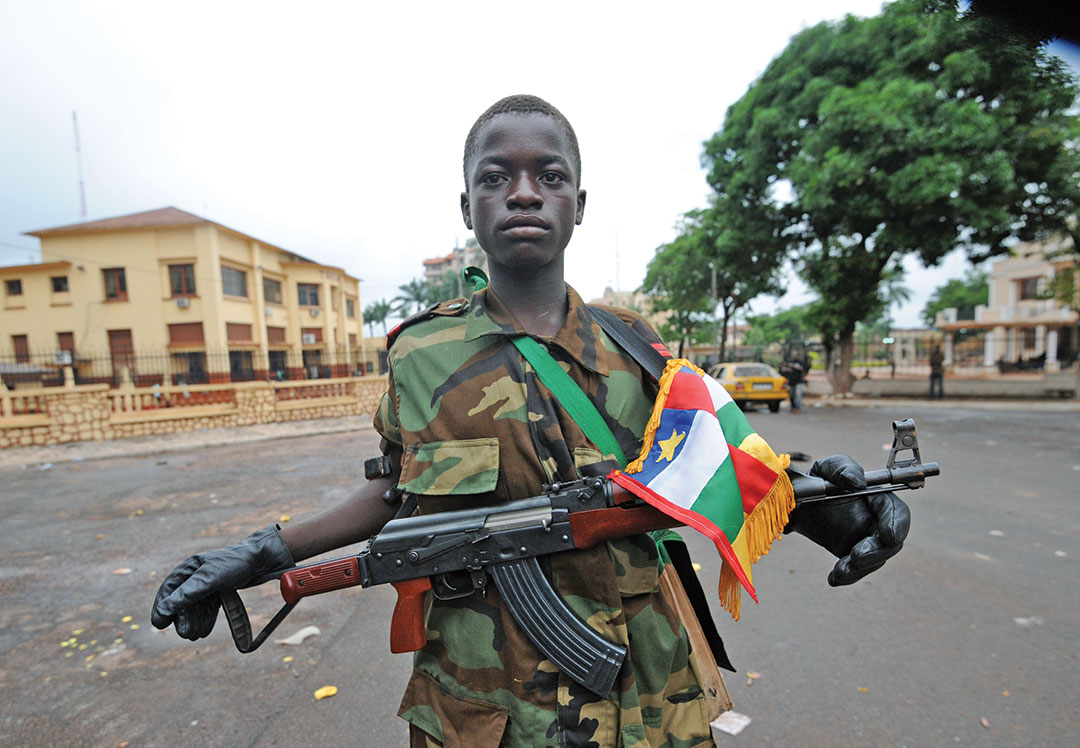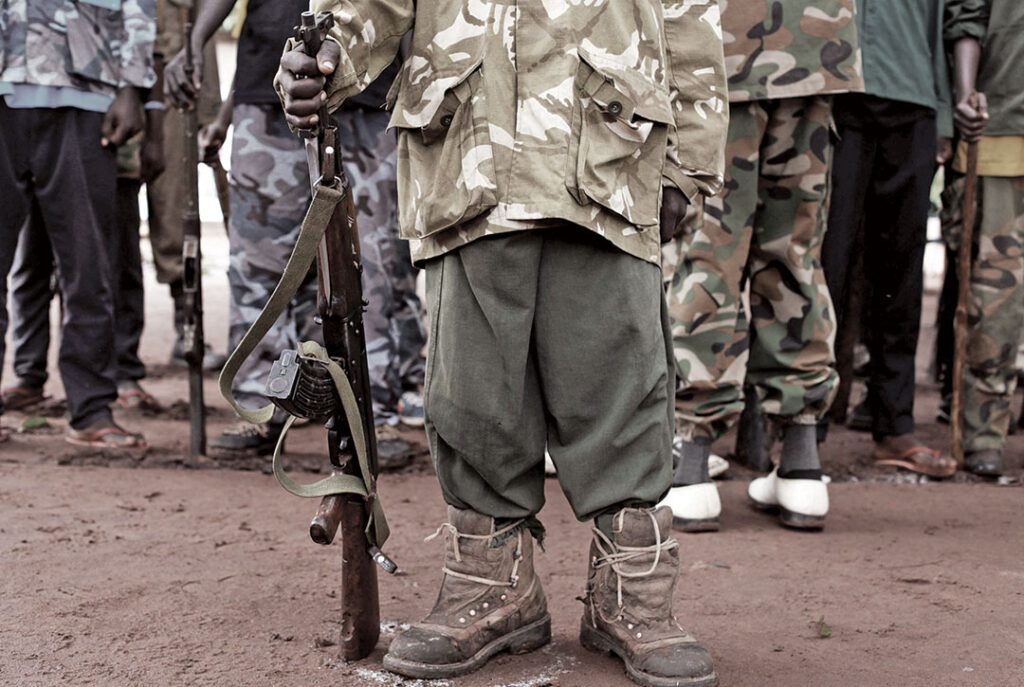ADF STAFF
M.K. was an unruly child, by his own admission.
The Idgwi island boy was not a good student. He didn’t listen to his parents or teachers. At age 13, he traveled to Goma, in the Democratic Republic of the Congo’s (DRC) North Kivu province, to visit his older brother. While there, members of the National Congress for the People’s Defence (CNDP) drove up in a car, stopped him and asked him for identification.
When M.K. said he did not have ID, members of the Congolese Tutsi anti-government militia tied him up, put him in the car and drove him to their camp in Kitchanga, where they threw him in a hole. He remained there for two months.
“Then, they took me out for questioning,” M.K. told the Voluntary Force at the Service of Childhood and Health in the DRC. “I had to choose between dying and working for them! They left me two hours to think about it (with water and food). I said to myself that if I refused, I was going to die because there was no one to help me or warn my family. If I worked for them, I would one day manage to find a solution.”
M.K. soon learned how to salute and how to handle a weapon. His captors appointed him to be an escort to a militia major. He began to smoke marijuana to keep his mind off his family. When the CNDP and the Armed Forces of the DRC (FARDC) signed a peace agreement in 2009, M.K. continued to work for his commander under the FARDC. A year later, the United Nations peacekeeping mission in the DRC took him to the Transit and Orientation Centre (CTO) for rehabilitation.

“For the two months since my arrival at the CTO, I’ve been rebuilding my life, starting from scratch so that I can be a better person and be in a position to help my family,” M.K. said.
M.K.’s story is a familiar one for thousands of African children. Many are kidnapped and forced into militias. Many serve on the front lines as rifle-carrying infantrymen. Others serve as cooks, spies, porters, escorts, messengers, and sometimes as domestic or sex slaves. Some are as young as 8 years old.
The experience can scar children for life — if they survive. Those lucky enough to escape or be liberated must be rehabilitated, a process that requires significant investments of time, resources and programs to ensure that young people leaving the battlefield can reenter society and be productive and safe.
THE BREADTH OF THE PROBLEM
Some have estimated that about 40% of all child soldiers are in Africa, but the problem exists worldwide. Children also have been exploited this way in Afghanistan, Burma, Colombia, Iraq, the Philippines, Syria and Yemen in recent years.
The numbers also have been growing. Child Soldiers International, whose programs now are operated by the Romeo Dallaire Child Soldiers Initiative, reported in February 2019 that the number of child soldiers had increased 159% worldwide in five years. The former London-based human rights group said that it had documented 30,000 recruitment cases since 2012. Many others almost certainly go unrecorded.
The former group told The Defense Post that 3,159 children were recruited in 12 nations in 2012. In 2017, the number soared to 8,185 children in 15 nations. Incidents of sexual violence against children also jumped by 40%. In 2012, there were 679 documented cases. In 2017, there were 951.

“Child recruitment is among the most desperate human rights issues of our time,” Isabelle Guitard, then director of Child Soldiers International, told The Defense Post. “These statistics alone are shocking and probably only scratch the surface on the true scale of child exploitation by armed actors around the world.”
The use of children in armed conflict — by any government, faction, rebel group or militia — contradicts most elements of what the United Nations Security Council calls the “Six Grave Violations Against Children During Armed Conflict.”
The six violations are:
- Recruitment and use of children.
- Killing or maiming of children.
- Sexual violence against children.
- Attacks against schools or hospitals.
- Abduction of children.
- Denial of humanitarian access.
The list informs the U.N. secretary-general’s annual global report on “Children and Armed Conflict” in which, among other things, violators are “named and shamed” for violations. The secretary-general’s 2018 report, which was released in June 2019, noted some of the most severe disregard for children since the report began. More than 24,000 violations were logged in 20 conflicts worldwide.
That total included the recruitment of more than 7,000 children into combat and support roles. Somalia had the highest number of recruited children, followed by Nigeria and Syria, the U.N. reported. Sexual exploitation numbers remained high with 933 cases, a total that surely falls far short of actual cases because of underreporting owing to related stigma. Again, the highest figures were noted in Somalia, followed by the DRC.
Child abductions continued in 2018, reaching nearly 2,500 reported cases, more than half of which were in Somalia.
WHY RECRUIT CHILDREN?
When considering the rigors and horrors of armed conflict, a logical question arises: Why recruit children into such a harrowing and demanding existence?

Children’s profound vulnerabilities often serve as a rationale for their recruitment. Children are seen by many armed groups as expendable. Because they are not yet mature, they do not have fully formed critical thinking skills and personalities. Some might be more fearless than adults because of their inability to critically assess the potential dangers facing them.
Because of this lack of mental and personal maturity, they can be more easily influenced and controlled, according to the African Centre for the Constructive Resolution of Disputes (ACCORD). If they lose their parents or other family members, they might become loyal to someone else, especially if that person “holds the power of reward and punishment,” according to author Michael Wessells, who wrote Child Soldiers: From Violence to Protection.
The proliferation of small arms across Africa and other conflict zones also makes children able to wield the tools of war. The Kalashnikov AK-47 assault rifle, a common weapon in Africa, is easily used by young people, as are most handguns, rifles and even machetes.
HOW CHILDREN ARE RECRUITED
The damage inflicted on children participating in war and conflict is universal. However, the reasons for and methods of recruitment of children as soldiers are not.
The recruitment of children falls into two broad categories: forced recruitment and voluntary recruitment.
In forced recruitment, children typically are abducted and compelled to fight, or they are born into militias or armed rebel groups.
The Lord’s Resistance Army, a Ugandan-based extremist group notorious for kidnapping and arming children, is thought to have forcibly conscripted tens of thousands of children since its formation in the mid-1980s.
The reasons that some children volunteer to fight for militias and armed groups are more complex. Sometimes it happens because they perceive discrimination against their people or repression by government authorities. Likewise, poverty and the lack of employment and education or having no remaining support community due to conflict can push young people to join armed groups, according to ACCORD.
In some cases, children may see armed groups as the only option for achieving security, food, money or acceptance. The allure may be as simple as a promise of a salary, a one-time monetary payment, battle spoils, or drugs and alcohol. The opportunity to achieve ranks and bond with a group of like-minded people also cannot be underestimated.
Even so, children cannot be considered solely responsible for voluntary recruitment. Joining an armed group is not usually a child’s choice, even if abduction is not involved. Sometimes, children determine that joining such a group might be their best chance of surviving.
“In other words, the universal condemnation of the recruitment of child soldiers needs to take the issue of alternatives into consideration,” the ACCORD report states. “What if the alternative is worse than becoming a child soldier? If the recruitment and re-recruitment of children as soldiers is to be prevented, then the economic, social and individual environment of potential recruits must be taken into account.”
REINTEGRATING CHILD SOLDIERS
Children who survive the horrors of combat and other involvement in armed groups must be counseled, trained and supported as part of a comprehensive reintegration program. The needs are staggering, as the services are expensive and require several years of involvement to fully reintegrate young people into society.
According to the U.N. secretary-general’s 2018 report, 13,600 children benefited from support for release and reintegration, up from 12,000 in 2017. In Africa, 2,253 children were released from armed groups in the DRC, 883 in Nigeria, and 785 were liberated in the Central African Republic.
“Releasing children from the ranks of armed elements is essential, but it is only a first step,” according to a 2018 U.N. report on reintegration. “Providing children who have been formally released with adequate services, as well as reaching out to those who have escaped or have been informally released, is a huge task.”
Reintegration is essential to breaking the cycle of violence and for helping avoid stigma in children’s communities. Failing to invest the time and money in this process can reverse gains made toward peace and stability.
Successful reintegration efforts must have certain guiding principles, according to the U.N. First, such programs must consider the best interests of the children, not just prevailing security or political concerns. Children associated with armed groups also must be looked at primarily as victims. Prosecuting and detention should be avoided when possible in favor of reintegration. Finally, children have a right to life, survival and development that addresses physical, spiritual, moral and social needs.
Effective reintegration programs should have the following components:
Psychosocial support and mental health: Trauma endured by child combatants can make going home difficult. Young people will need help finding their place in society once they have been liberated from fighting.
Educational and vocational opportunities: Conflict can close schools and hobble economies. “Offering former child soldiers a viable alternative to bearing a weapon may be the most important aspect of reintegration,” according to the U.N.
Gender-sensitive programming: Girls’ experiences are unique, and they often suffer sexual violence, pregnancy and stigma. It is common for girls to be reluctant to join reintegration programs because they fear rejection by their families. Programs must prioritize their education and vocational training.
Reintegration is a long-term process.
It will require adequate funding over the required amount of time. Ensuring this will complete the healing process and help keep children from falling back into the hands of armed groups.
GLIMMERS OF HOPE
Although the problem persists, officials in Africa and elsewhere realize the damage done by using children in combat. A November 2019 conference in Juba, South Sudan, brought together government and opposition forces to discuss the use of child soldiers, according to ReliefWeb.
More than 50 senior officers attended the three-day conference led by the U.N. Mission in South Sudan’s Child Protection Unit and UNICEF.
Participants outlined several actions, including educating junior officers on the issue, improving ways to identify young people under 18, and increasing efforts to find and release children working as soldiers. The conference also stressed reintegration as a crucial component.
“Children need to be dissuaded from joining the military and should instead be motivated to be at school,” said Andrew Oluku, an officer with the National Disarmament, Demobilization and Reintegration Committee. “The government needs to take more responsibility for the youth because they are the backbone of this country.”

